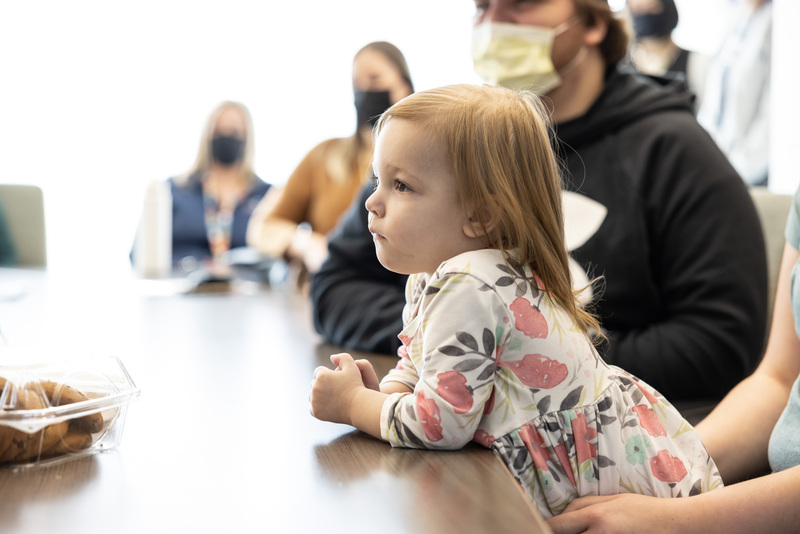Use Intermountain Connect Care®
Learn More.
How can we help?

Two-year-old Eva has shown her liver transplant scar to many grown-ups, but none were as special as the living donor who made history at Intermountain Primary Children’s Hospital – and saved Eva’s life.
Kate is the first person in Utah to become a two-organ living donor. The 37-year-old mother is among the 155 people nationwide who have donated both a kidney and part of their liver to save the lives of others.
Kate donated a kidney to woman she met while working in the Washington, D.C., area. She gave part of her liver to little Eva, who at the time was a total stranger.
“I’m very happy that I did it,” Kate said after meeting Eva at Intermountain Primary Children’s Hospital late last year. “She’s super cute and silly, and exactly the way a 2-year-old should be.”
Living-donor liver transplants occur when a portion of a living person’s liver is removed and surgically placed into another person whose liver no longer works properly.
After the surgery, the donor’s liver regenerates to its regular size within about two months. In the recipient, the transplanted liver grows to fit his or her body, and functions as a healthy liver.
“Living donor liver transplants not only significantly increase the number of available organs for children waiting for a transplant, but they also reduce the waiting time for children who urgently require a liver transplant, saving their lives,” said Cecile Aguayo, pediatric transplant services director at Intermountain Primary Children’s Hospital.
“Moreover, the use of living donors also enables the transplant to be performed before the child’s condition deteriorates, resulting in better outcomes and quality of life post-transplant,” Aguayo added.
Primary Children’s has been a national leader in living-donor liver transplants since 1997, when it became the first center in Utah to successfully perform the procedure. At that time, Primary Children’s was among very few pediatric hospitals in the country that had saved a child through living-donor liver transplantation, Aguayo said.
Since 1997, 42 living-donor liver transplants have taken place at Primary Children’s Hospital. Primary Children’s also has the largest liver and disease transplantation program in the Intermountain West, and attracts and serves patients from all over the world.
Kate became interested in being a living organ donor in the early 2000s. While living in the Washington, D.C., area, Kate found an opportunity to help.
A woman who worked in the same building had a disease affecting her kidneys. The pair became friends, and when Kate learned the woman needed a kidney transplant, they discovered they had the same blood type. Kate offered to become her donor.
Eventually, the woman accepted. Kate said that today, the woman is doing great, and the pair remain friends.
When Kate moved to Utah, she contacted Primary Children’s Hospital and offered to donate part of her liver to help a child in need.
That child ended up being baby Eva, who was being treated for biliary atresia since she was just two months old.
“It was nine months of waiting (for a matching liver donor),” said Eva’s mom, Alyssa Anderson. “Without intervention, her liver would have failed, and she would have died. Most kids with this disease years ago wouldn’t have even lived to see their first birthday.”
Around the time of her first birthday, Eva received part of Kate’s liver. After a year of healing, Eva’s liver transplant team arranged for Eva and her parents to meet Kate at Intermountain Primary Children’s Hospital.
“I was kind of starstruck,” Eva’s mom said of meeting Kate. “I said, ‘You’re a real person, you’re normal, and you’re just like me.’ She’s a mom, just like me.”
“I wanted to show her all the pictures and make sure she understood that she saved my baby’s life,” she added. “All of our family is so grateful to her.”
Eva is walking, dancing, and loves to go down the slide at the playground. “We’re loving to watch her thrive, and learn new words and new tricks,” her mom said.
Kate said the experience has been rewarding for her, too.
“It’s a wonderful experience to help someone, even in general. Like when you open the door for someone, they’re just really happy about it … and it makes your day to help,” Kate said. “So, imagine the opportunity to donate and save someone’s life.”
Anderson says she hopes to follow Kate’s example someday, and pay it forward to another family. “You don’t know how much it means to the people you’re saving.”
For information on how to become a living organ donor for a child, visit primarychildrens.org.
###
Meda Note: photos and video available upon request